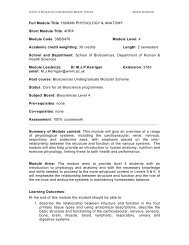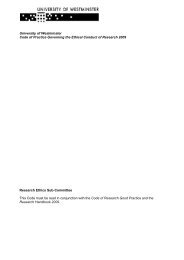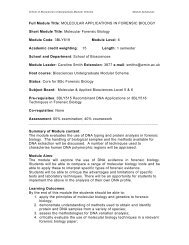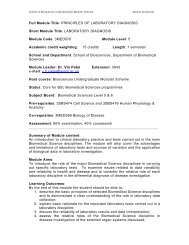CONTENTS 1. Introduction 1.1 Course Outline 1 1.2 Introduction ...
CONTENTS 1. Introduction 1.1 Course Outline 1 1.2 Introduction ...
CONTENTS 1. Introduction 1.1 Course Outline 1 1.2 Introduction ...
You also want an ePaper? Increase the reach of your titles
YUMPU automatically turns print PDFs into web optimized ePapers that Google loves.
Full Module Title:<br />
COLOUR IMAGING SCIENCE<br />
Short Module Title: COLOUR SCIENCE<br />
Module Code: 2DPI613 Module Level: 6<br />
Academic credit weighting: 15 credits.<br />
Length: 1 semester<br />
School:<br />
Media, Art and Design.<br />
Department:<br />
Photographic and Digital Media<br />
Module Leader: Sophie Triantaphillidou extension: 4584 e-mail: triants@wmin.ac.uk<br />
Host <strong>Course</strong>:<br />
BSc(Hons) Photography and Digital Imaging<br />
Status:<br />
Option<br />
Pre-requisites:<br />
None.<br />
Co-requisites:<br />
None.<br />
Assessment: Practical work 40%, coursework 20%, written examination 40%.<br />
Summary of Module content:<br />
Colour reproduction is studied in the context of the human perception of colour, the technical<br />
features of methods available for colour reproduction and its quantitative assessment through<br />
colorimetry and colour systems. The limitations of colour reproduction systems are explored<br />
together with methods of device characterization and colour calibration. The module provides<br />
and introduction to gamut mapping and colour management systems. Current metrics describing<br />
colour reproduction quality are introduced and applications are described. Colour appearance<br />
phenomena and models are discussed.<br />
Module Aims:<br />
The module provides an understanding of the fundamental principles of colour vision and colour<br />
reproduction and enable the students to characterize quantitatively colour, its communication and<br />
reproduction.<br />
Learning Outcomes:<br />
On completion of the module the successful student will be able to:<br />
<strong>1.</strong> Understand the principles advantages and limitations of colorimetry.<br />
2. Gain an understanding in developments in digital colour reproduction.<br />
3. Assess quantitatively the quality of digital colour reproductions and systems.<br />
4. Characterise the output of colour reproduction systems.<br />
5. Extend the scope of colour reproduction into quantitative or instrumental, applications if<br />
required.<br />
6. Gain an understanding on ICC colour management.<br />
7. Understand the principles behind colour appearance models.<br />
8. Report and communicate on experimental results.<br />
Indicative syllabus content:<br />
Human colour vision and related perceptual effects: The human visual system: anomalous colour<br />
vision, adaptation, spatial induction effects.<br />
The specification of colour: Physical, comparative and synthetic methods. Metamerism. CIE<br />
standard methods of colour specification. Colour order systems. Colorimetry and CIE colour<br />
spaces.<br />
Colour reproduction systems and colour correction: Principle, limitations and applications of<br />
additive and subtractive methods of colour reproduction. Corrective methods and mechanisms.<br />
Colour spaces and digital imaging: Advantages and limitations of device-dependent and deviceindependent<br />
colour spaces used in the digital domain.<br />
The analysis of colour reproduction: A survey of methods of device characterization required for<br />
calibration of digital colour reproduction systems. Case studies of complex imaging applications in<br />
digital colorimetric reproduction.<br />
DPI_Hbook 86 ©University of Westminster
















